Space Shuttle Launch Complex 39-B Construction Photos
Page 48
RSS Anteroom Extension Installation (Original Scan)
They eventually decided that the room you enter the main floor level of the PCR through was too small, and so they ran framing all along the back side of the RSS and made that whole area the new PCR Anteroom. Whereas before, there was hardly enough room for a desk with someone sitting behind it to check your credentials and let you open the door and walk into the air shower, now they had themselves a capacious volume that could accommodate numerous people and a variety of paraphernalia. This occurred after the pad had become active over at A, but before the pad became active on B. When I had my misadventure with the live payload stack over at A Pad, we'd entered through the old, small and cramped, anteroom. We departed, needless to say, traveling across the deckplate and catwalks to the FSS elevators as fast as our feet could safely carry us, via the direct route, through the emergency exit doors of the PCR Equipment Airlock, skipping the air shower and the anteroom altogether in our haste to get the hell out of there.
Here in these photos, you see a gang of ironworkers (And that's what they're called, a gang, and there can be three or four, or maybe as many as six or seven, or, really, as many as it takes, ironworkers in a gang, circumstances depending, and they'll oftentimes keep their common tools and equipment, and sometimes their personal stuff too, in a gang box, which will be moved around to keep it near whatever work area they might be working, at any given time.) doing their thing, as nonchalantly as you or I might get up out of a chair and walk into the kitchen to get something out of the refrigerator. There's nothing at all beneath the beams and columns these guys are putting into place and walking around on. Sheer drop to the pad deck. Lethal. Eighty-plus feet. No chance of survival. None. So now go look at what those guys are walking around on a little closer again, please, and maybe try to consider things a little bit more than you might have at first glance. Maybe see if you can place yourself in one of those pairs of boots if you can. Maybe try to feel things a little bit, if you can. Come on out on the iron with us. You can do it. You'll be ok.
In the top right photo, you can see Gene Lockamy (I sure hope I'm spelling your last name right, Gene) directing the crane operator with hand signals, while a pair of ironworkers employ a spud wrench to force the column they are setting to properly line up with the bolt holes in the piece it sits on top of.
This is how the iron gets hung.
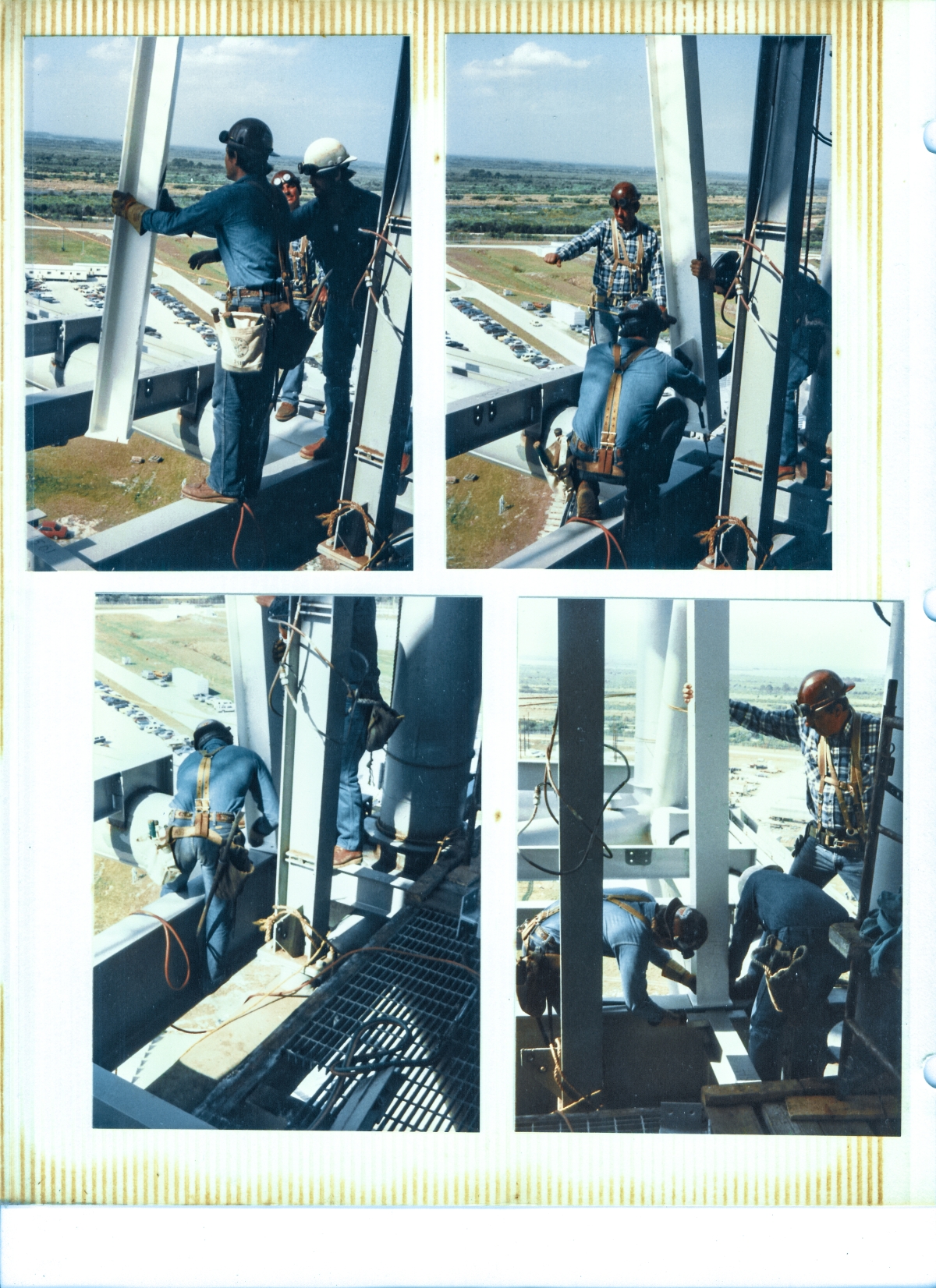
Top Left: (Full-size)
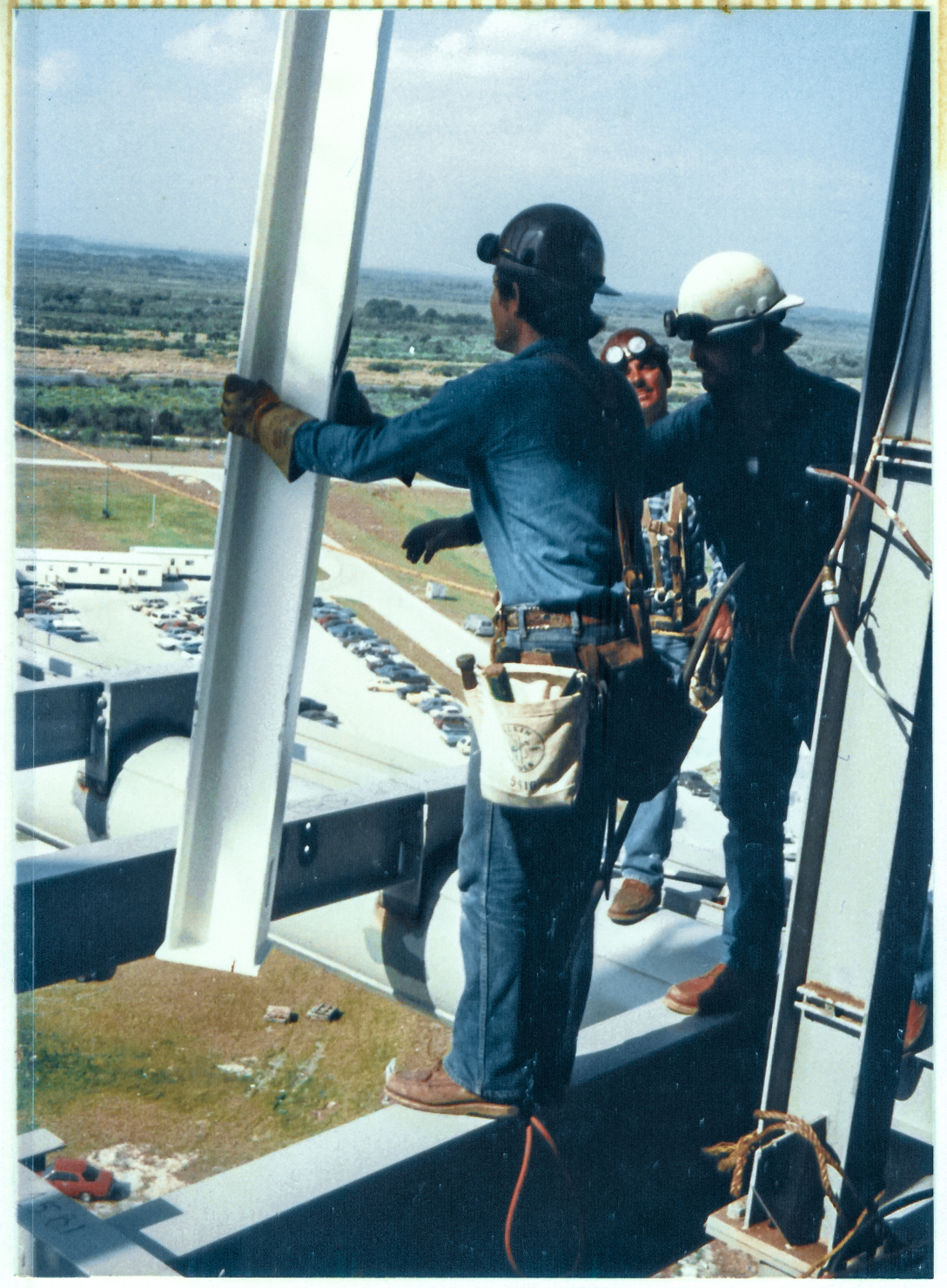
You're almost ninety feet above the concrete of the pad deck, unseen below you. You're one-hundred thirty feet above the cars in the parking lot, in the distance beyond three ironworkers.
Gene Lockamy is the ironworker foreman, and that's him facing in our direction, looking above us toward where the column that's being negotiated into place is tied to the lifting gear that's being used to get it up to this elevation and then maneuvered into place on the iron they're all standing on.
Gene is a Good Man, and is one of the best ironworkers you'll ever meet, which is why he's the foreman.
Quiet. Soft-spoken. Knowledgable. Hard-working. Possessed of all the innate sense and savvy that's required to make things happen, up on the iron.
Gene would hate me if he saw these words. He doesn't go in for any of that goddamned high-sounding crap. But I don't care. It's true. And this is my story, and I'm gonna tell it the way I want to. Fuck you, Gene.
Our other two ironworkers must remain unnamed, unfortunately, and although I have no personal recollection of either one of them, I know that they were both good hands. If they had not been good hands, they would never have made it to this place, under Gene's supervision.
You are looking at a very thin slice of day-to-day life for a Union Ironworker.
Maybe take notice of a few things while we're up here, perhaps.
We'll start with where we are.
And where we are, is
along the very back of the RSS, right alongside Column Line 'A', and very near Column Line 6, down at the main flooring level of the RSS at the 135' elevation.
Gene is standing on a 24-inch diameter steel pipe with nothing at all around him, to maybe lay a hand on to perhaps steady himself every once in a while.
When you're up in the air, pipes are scary motherfuckers.
And here's Gene, not even seeming to notice.
And it's not enough that the damn thing has no flat level place to provide proper level footing on, it's also got a bunch of stuff that's been welded onto it, which stuff constitutes a tripping hazard and one must be very goddamned careful when one goes sauntering merrily down the length of such a thing.
And yet, here we are.
Of other note is the fact that we're dealing with "light iron" here. Piddly stuff, in fact. Just from nothing more than an eyeball-examination of what they're about to set down on existing iron, I'm guessing it's probably a W8x15, which is a very common structural shape, and as its name tells you, (even though you're not expected to know this) it weighs 15 pounds per running foot. Guess at a length of nine or ten foot (let's go with nine, just because) which you could reasonably expect for something that's going to be carrying roof framing steel above floor level, we're looking at about 135 pounds of mass swinging around over there on the end of a crane hook, and 135 pounds is waaay more than plenty enough to knock your ass clear off of the iron you're standing on if it catches you unawares (And are you going to just
Mind yourself, ok?
Light iron.
Top Right: (Full-size)
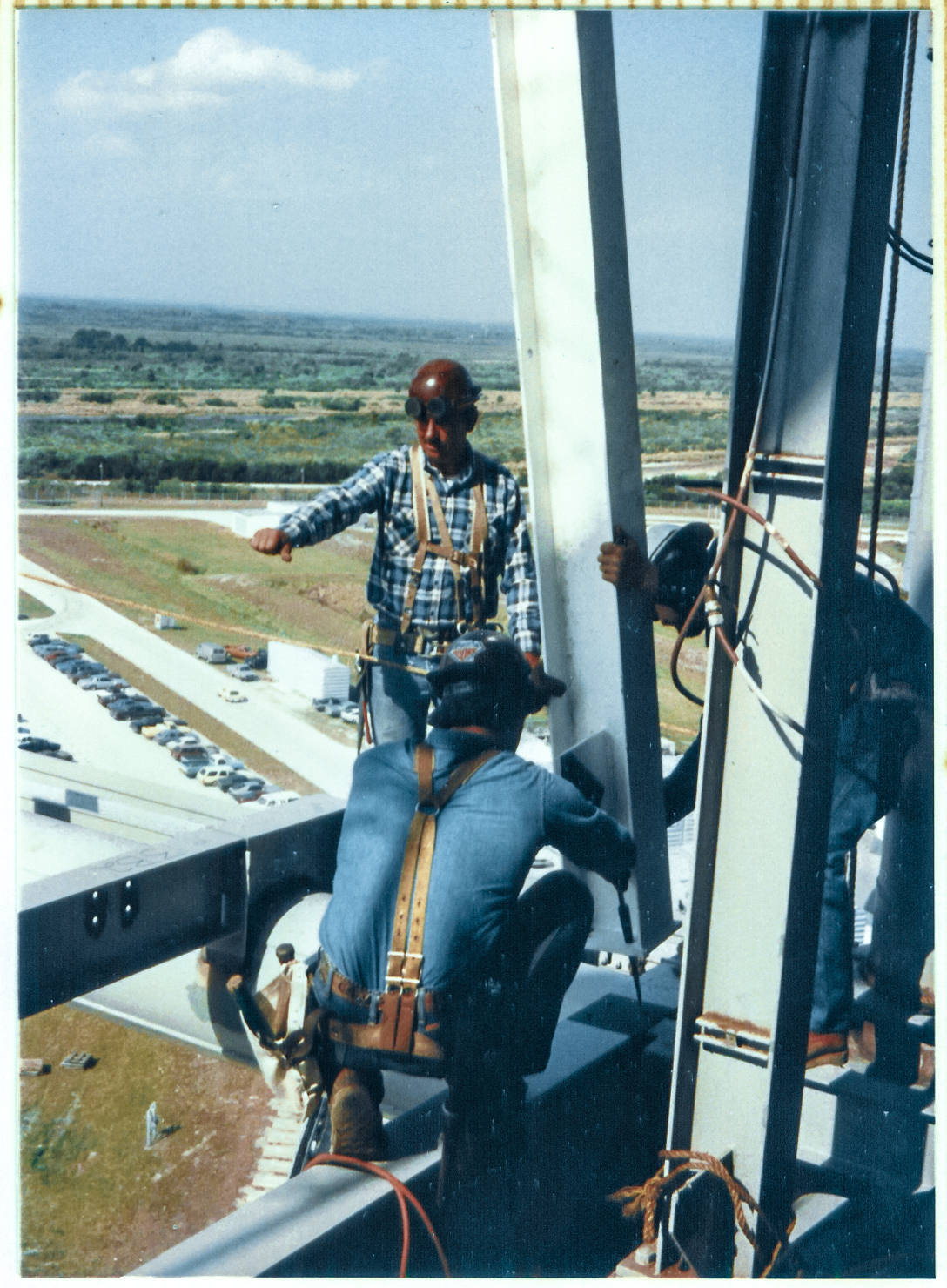
And here's your sterling example of how it's done.
Spud wrench.
One of those funny-looking open-end wrenches with the long pointy tail on it that you will invariably see one or more of, hanging off of every ironworker's toolbelt somewhere.
And in this image you get a perfect look at what that long pointy "tail" is all about.
Gene directs the lift with hand-signals.
Our two connectors will be connecting the iron.
The piece that's about to be connected is still suspended by the crane, or the tugger, or whatever, and it's closing in on what it's going to be connected to (gently now, gently), and as it approaches the area where it needs to be, it's asking too much of humans and the equipment they run to just set it in there perfectly, ready to be bolted up, so instead, we help it along some by shoving the long skinny tail of our spud wrench into one of the bolt holes on the base plate, or clip angle, or whatever of the piece we're guiding in, and when it gets close enough, we keep pushing the wrench, tail-first, till it can catch on and get shoved down into, one of the bolt holes on the piece we're connecting to, and then the lift operator is instructed to come down (or across, or wherever), on it as we keep it pinned in place with our spud wrench, and as the two pieces come in contact we can expect them (perhaps with the help of a little hands-on main force) to be sufficiently aligned to permit somebody to get on it with inserting bolts through the now-matched pairs of bolt holes in both pieces, working nuts on to the threaded end of the bolt that's now protruding through the matched set of bolt holes and then using the other end of a spud wrench to start torquing that motherfucker down.
Nothing to it.
Mind your hands, though.
Your fingers, in particular.
That's some heavy stuff you're working with there, and it would be a shame if you had a finger in an unfortunate location when a choker sling chose the worst possible time to slip, even just an inch, or something unseen above and behind you inadvertently bangs into the piece you're working and maybe spins it around a little bit, or perhaps the piece you're spudding-in takes a sudden lurch that near-instantaneously snatches the end of the spud wrench you're holding and smashes it against the web of the column you're connecting before you can get your fingers out of the way, or....
Mind yourself, ok?
Bottom Left: (Full-size)
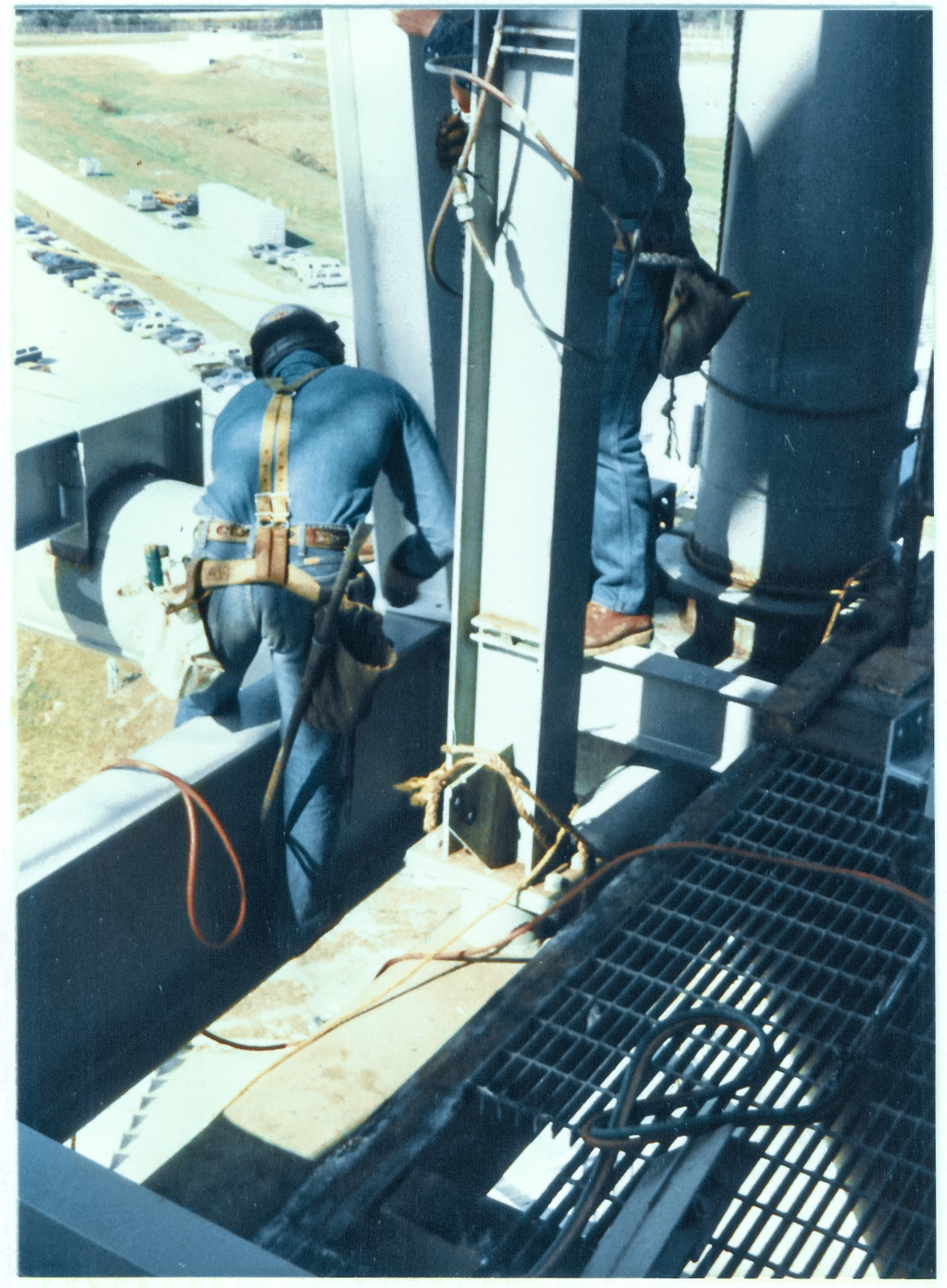
And the work goes on, high above nothing at all. Well... except maybe for that concrete down there.
Bottom Right: (Full-size)
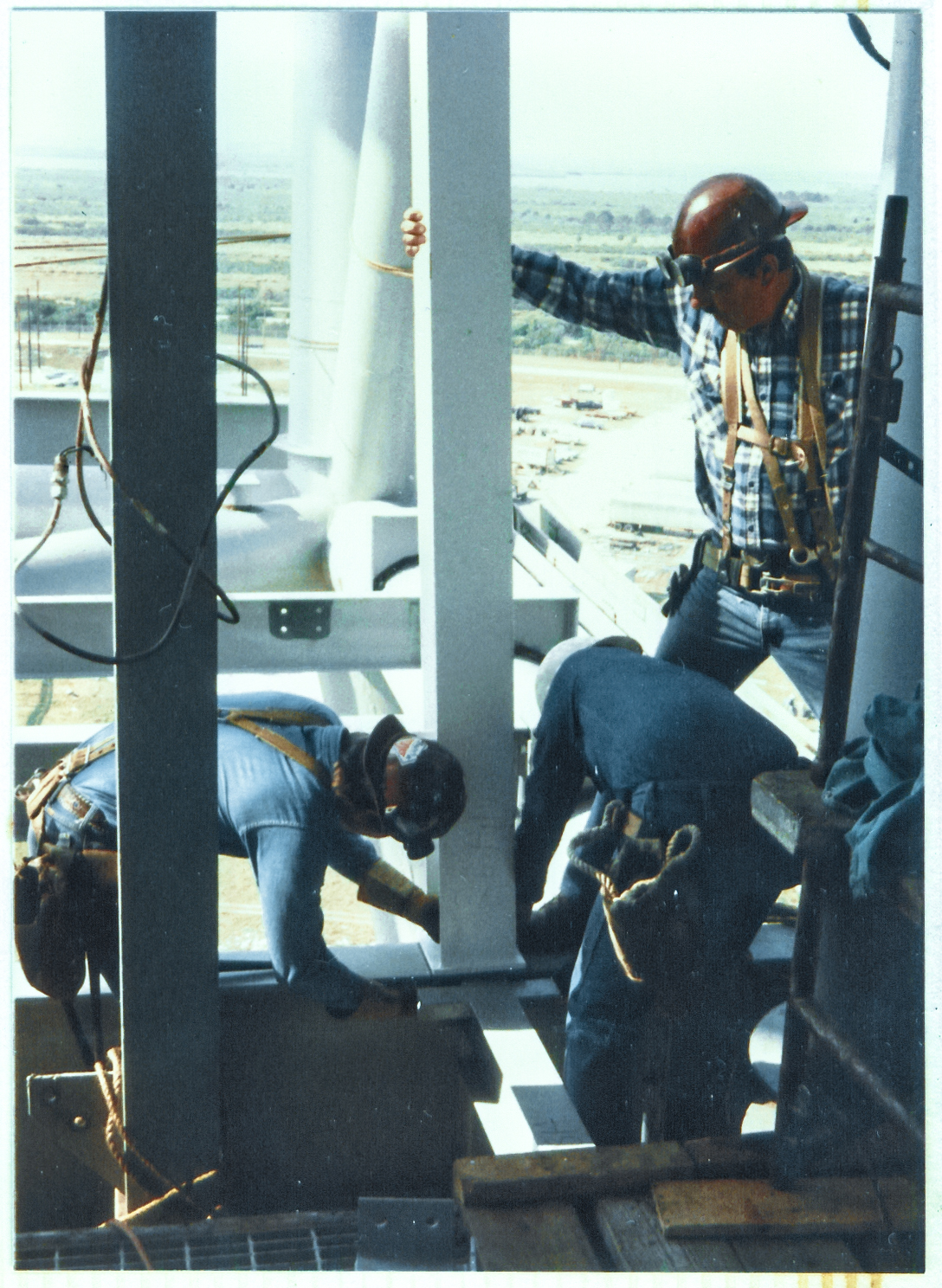
And that's how the iron gets hung.
Return to 16streets.comACRONYMS LOOK-UP PAGEMaybe try to email me? |